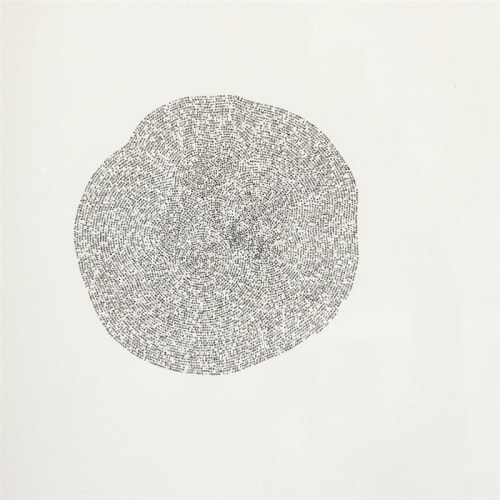Kim is interested not only in how presentation changes information, but how the act of recontextualisation can affect its meaning and significance.
The intensely detailed, hand-drawn work of Clare Kim consists of tightly-rendered lines of text used to create figurative objects and abstract forms. Her pieces explore the nature of spiritual and cultural narrative and the transformation of textual information in a fine art context.
Although drawing material from a diverse range of sources, Every Thing Ever Wanted is particularly concerned with mythologies, folklore and Christianity; texts and forms often address personal and universal desires for love, happiness and immortality. Minutely repeated phrases such as “all has been consecrated” and “you will live forever” bring to mind fervent prayers or talismanic spells. These works become amulets of fortune and objects of protection for their bearer.
Every Thing Ever Wanted reveals archaic moral and religious stories, reflecting nostalgia for a purity of information that is virtually non-existent in contemporary society with the internet’s dissemination of ideas creating an abundance of information which is increasingly meaningless. Kim repackages shared cultural knowledge drawn from digital sources, books and oral narratives in a form that redirects attention to the value of this information. These texts are treated equally, whether ancient and sacred or contemporary and questionable. Kim reimagines each text as a private and meaningful thought, emerging from the white noise of modern media.
Concerned with art-making as a transformative process, Kim is interested not only in how presentation changes information, but how the act of recontextualisation can affect its meaning and significance. Kim’s manual transcription of text on the tiny scale at which she works is astonishingly demanding, requiring almost superhuman precision, perseverance and commitment. Thus, her work itself takes on a spiritual or religious quality; the devotion of time to the creation of these text-objects echoes the work of monks through the Middle Ages reproducing religious texts. There is a fervency that suggests a transcendence of human limitations, adding further significance to the texts and the art-making process.
The forms of the works are often physically determined by the texts themselves. An untitled work drawn in the form of an apple asserts “eat me,” at once recalling the forbidden desires of Snow White, Alice in Wonderland and the Book of Genesis; an intricate skull form consists of text about death taken from Wikipedia; an abstract form in red ink spells out the Korean word for “treasure” in the Hangul alphabet.
Drawing from such varied sources as Wikipedia entries, biblical texts and fairy tales, Kim democratises text, destabilising the power structures that we rely on to authorise information. Thus, Kim’s work challenges the paradigm of the Information Age by reinvesting text with the beauty and complexity it once possessed. The delivery of information in her work is paradoxical – though the information is obvious, it is ultimately inaccessible. This calls attention to the way we perceive images and information in a contemporary context and questions whether fairy tales, mythology and doctrinal texts can be made relevant in an image-dominated society. In this way, Kim’s work encourages viewers to take a reverential view of written knowledge and information and to regard it as art in its own right.
